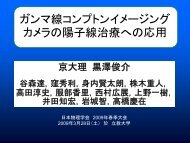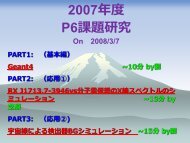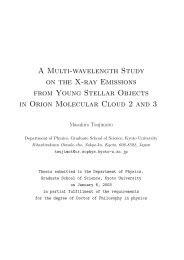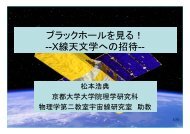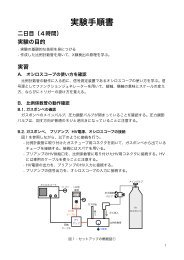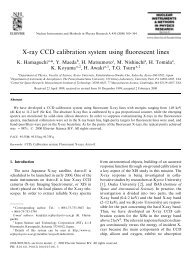X-ray Study of Low-mass Young Stellar Objects in the ρ Ophiuchi ...
X-ray Study of Low-mass Young Stellar Objects in the ρ Ophiuchi ...
X-ray Study of Low-mass Young Stellar Objects in the ρ Ophiuchi ...
Create successful ePaper yourself
Turn your PDF publications into a flip-book with our unique Google optimized e-Paper software.
78 CHAPTER 6. INDIVIDUAL SOURCES6.4 Brown DwarfsImanishi et al. (2001b) did a systematic X-<strong>ray</strong> search from bona-fide and candidate brown dwarfs<strong>in</strong> <strong>ρ</strong> Oph. Here, we show details.6.4.1 X-<strong>ray</strong> detection from brown dwarfs <strong>in</strong> <strong>ρ</strong> OphIn <strong>the</strong> fields <strong>of</strong> view <strong>of</strong> obs-A and obs-BF, 18 late M dwarfs have been reported based on <strong>the</strong> watervapor absorption at λ = 2.4–2.5 µm (Wilk<strong>in</strong>g et al., 1999; Cush<strong>in</strong>g et al., 2000). Among <strong>the</strong>m,eight sources have <strong>the</strong> upper limit <strong>of</strong> <strong>the</strong> <strong>mass</strong> less than 0.08 M ⊙ , which we call “bona-fide browndwarfs” (here and after, BDs).O<strong>the</strong>r seven sources have <strong>the</strong> lower limit <strong>of</strong> <strong>the</strong> <strong>mass</strong> less than0.08 M ⊙ , which is called “candidate brown dwarfs” (BD c s) 3 . Table 6.5 shows <strong>the</strong>ir names andspectral types.In <strong>the</strong> X-<strong>ray</strong> source catalogue (Table 5.2), we found X-<strong>ray</strong> counterparts for four BDs and BD c s(A-30 = GY37, A-38 = GY59, BF-86 = GY310, and BF-S2 = GY141). Also, a BD c GY5 maybe associated with a s<strong>of</strong>t-band source A-S2, although Imanishi et al. (2001b) reported no X-<strong>ray</strong>emission from GY5 by us<strong>in</strong>g <strong>the</strong> NIR position <strong>of</strong> Barsony et al. (1997), which is ∼2 ′′ away from<strong>the</strong> 2MASS source. S<strong>in</strong>ce no apparent X-<strong>ray</strong> sources are found <strong>in</strong> <strong>the</strong> error radius <strong>of</strong> <strong>the</strong> o<strong>the</strong>r 11catalogued BDs and BD c s, we def<strong>in</strong>e a circle with a half radius <strong>of</strong> <strong>the</strong> PSF size around each IRposition, <strong>the</strong>n manually count X-<strong>ray</strong> photons. We note that a ra<strong>the</strong>r small source radius is selectedso as to <strong>in</strong>crease <strong>the</strong> signal-to-noise (S/N) ratio, particularly for fa<strong>in</strong>t X-<strong>ray</strong> sources. Never<strong>the</strong>less,as is demonstrated <strong>in</strong> <strong>the</strong> bright sources, <strong>the</strong> position error between IR and X-<strong>ray</strong> is always smallerthan <strong>the</strong> source radius, because both have generally similar dependence on a source <strong>of</strong>f-axis angle;both have <strong>the</strong> smaller values for sources with smaller <strong>of</strong>f-axis angle. Therefore, most <strong>of</strong> <strong>the</strong> X-<strong>ray</strong>photons for <strong>the</strong> relevant BDs and BD c s, if any, may fall <strong>in</strong> <strong>the</strong> source circles. Table 6.5 shows <strong>the</strong>X-<strong>ray</strong> counts thus counted. The mean background counts are estimated from <strong>the</strong> same regions used<strong>in</strong> §5.6. The s<strong>of</strong>t band (0.5–2.0 keV) background counts (<strong>in</strong> units <strong>of</strong> 10 −2 counts arcsec −2 ) are 2.3and 2.2 for obs-BF and obs-A, respectively, while those <strong>in</strong> <strong>the</strong> hard (2.0–9.0 keV) band are aboutthree times larger, 6.8 and 6.5 for obs-BF and obs-A. The background counts <strong>in</strong> each source areaare given <strong>in</strong> Table 6.5. We <strong>the</strong>n separately calculate <strong>the</strong> confidence level (CL) <strong>of</strong> X-<strong>ray</strong> detectionfor <strong>the</strong> s<strong>of</strong>t, hard, and total (0.5–9.0 keV) bands. Based on <strong>the</strong> Poisson statistics, we def<strong>in</strong>e <strong>the</strong> CLasCL =N∑0 −1N ′ =0e −N N N ′bg bgN ′ ! , (6.2)3 Imanishi et al. (2001b) regarded GY31, GY163, and GY326 as BD cs. Now, however, <strong>the</strong> <strong>mass</strong> <strong>of</strong> <strong>the</strong>se M dwarfsis regarded to be higher than <strong>the</strong> hydrogen burn<strong>in</strong>g limit (Wilk<strong>in</strong>g et al., 1999), hence we do not <strong>in</strong>clude <strong>the</strong>m <strong>in</strong> <strong>the</strong>BD c sample.






